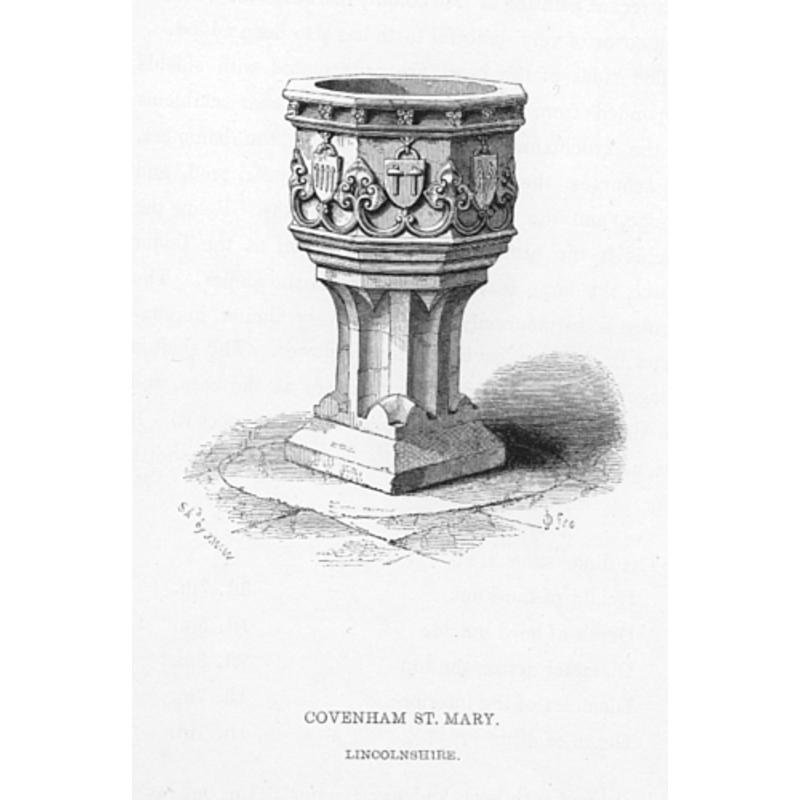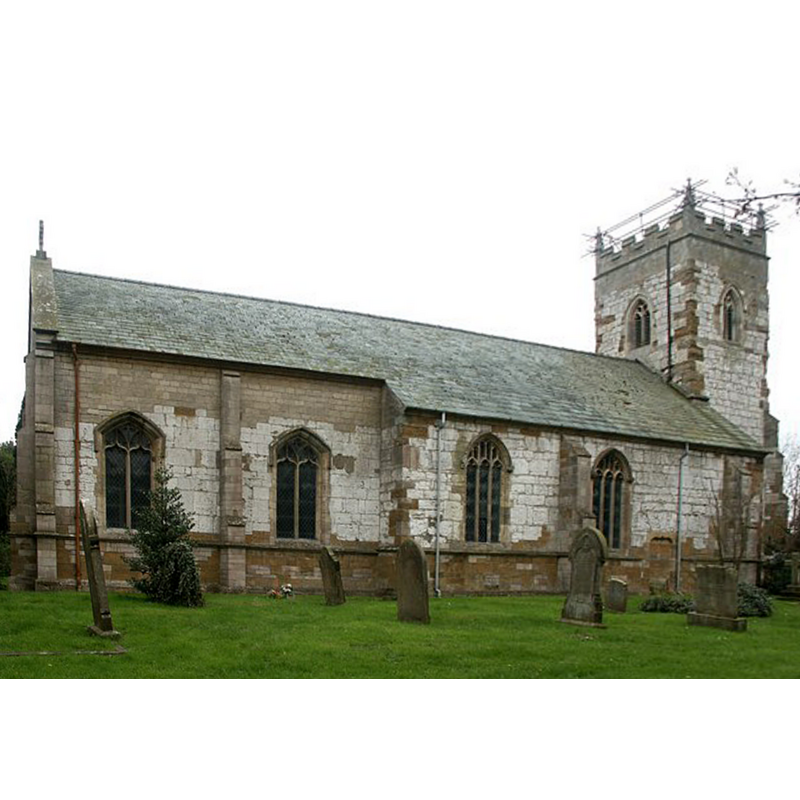Covenham St. Mary

Image copyright © [in the public domain]
PD
Results: 6 records
design element - motifs - floral - Tudor flower - 8
design element - motifs - floral - rosette - 4 petals - 16
symbol - shield - cross
symbol - shield - emblem - Christ - the instruments of the Passion
view of church exterior - northeast view
INFORMATION
FontID: 01634COV
Object Type: Baptismal Font1
Church/Chapel: Parish Church of the Annunciation of the Blessed Virgin Mary [C&H give St. Bartholomew]
Church Patron Saints: The Annunciation to St. Mary
Church Location: Main Rd, Covenham, Louth LN110XG, UK
Country Name: England
Location: Lincolnshire, East Midlands
Directions to Site: Located off (E) the A16, near Covenham St Bartholomew, about 8 kms N of Louth
Ecclesiastic Region: Diocese of Lincoln
Historical Region: Hundred of Ludborough
Font Location in Church: Inside of the church, W end of the nave, near the N door
Century and Period: 15th century, Perpendicular
Workshop/Group/Artisan: heraldic font
Cognate Fonts: [cf. FontNotes]
Font Notes:
Click to view
There are two entries for Covenham [St Bartholomew and St Mary] in the Domesday survey [https://opendomesday.org/place/XX0000/covenham-st-bartholomew-and-st-mary/] [accessed 10 February 2019], one of which reports a church in it [cf. infra]. The Covenhams site [https://covenham.org.uk/stmary.htm] [accessed 10 February 2019] notes: "Probably St Bartholomew's was the church of a small priory, where the monks and their servants would say the daily services. St. Mary's was the Church for the people of the parish. In the Domesday Book it is recorded that there was already a church in the parish and Esbern is described as the priest. This church was most probably St. Mary's and the older of the two. [...] The font is also Perpendicular in style and has an unusual pattern. The rim of the bowl is dotted with flowers and around the sides are shields with instruments of our Lord's Passion Such as crosses, nails, hammers and scourges." Paley (1844) has: octagonal mounted font of the 15th century in the Perpendicular style; it is ornamented with a row of four-petal rosettes between the upper rim and a moulding; below the moulding, on each side of the octagonal basin, there is a shield "suspended from hooks, five of which bear emblems of the Crucifixion, as the four nails, the hammers, the scourges, the crown of thorns, the spear, reed, and sponge, and the other three have crosses; below the shields are Tudor flowers, the large leaves of which cover the angles." The underbowl is made of a triple moulding. The stem of the base has its corners hollowed out to appear octagonal except at the bottom where it has a square plant. There is no plinth. Paley (ibid.) reports that "the sculptures and mouldings are in good preservation, but we regret that the effect of the Font is entirely destroyed by a recent painting of lead colour marbled over!"; he also informs that the basin is lined with lead and has a water drain "but, as too frequently the case, it is filled up with dirt" (ibid.) Noted in Sutton (1898), who writes: "We have seen several intreresting fonts in this district, but not one equal to the one in this church for beauty of design or boldness of execution. It is octagonal in form. Round the rim is a small double moulding with square flowers carved at intervals. The sides are adorned with shields with the instruments of the passion carved on each, and round the underneath part is a bold design, terminating with leaves the points of which are at each angle. The whole rests on rather a plain base. This font is standing on a circle of stone, which rather looks as if it might be a portion of a Norman font." Noted in Pevsner, Harris and Antram (1989): "Font. Octagonal, Perp[endicular], an unsual pattern (but cf. East Barkwith). A frieze of little round arches upside down and with finials shields with the Instruments of the Passion." A font found buried beneath the church floor is reported in Stocker (1997), perhaps referring to the "circle of stone" mentioned in Sutton [cf. supra]. The entry for this church in Historic England [Listing NGR: TF3396594324] notes: "Parish church. c.1359, C15, late C18, C19. [...] The C15 octagonal font with moulded top has fleurons, beneath which are shields on each face separated by foliage. The base is moulded with stop chamfers to angles."
COORDINATES
Church Latitude & Longitude Decimal: 53.42887, 0.0153
Church Latitude & Longitude DMS: 53° 25′ 43.93″ N, 0° 0′ 55.08″ E
UTM: 31U 301712 5924130
MEDIUM AND MEASUREMENTS
Material: stone, limestone
Font Shape: octagonal (mounted)
Basin Interior Shape: round
Basin Exterior Shape: octagonal
Drainage Notes: lead lining [cf. font notes]
Rim Thickness: 10 cm
Diameter (inside rim): 47.5 cm
Diameter (includes rim): 67.5 cm
Basin Depth: 32.5 cm
Basin Total Height: 50 cm
Height of Base: 57.5 cm
Font Height (less Plinth): 107.5 cm
Notes on Measurements: Paley (1844: unpaged)
LID INFORMATION
Date: modern
Notes: "A modern cover of very doubtful taste has also been added" (Paley, 1844: unpaged)
REFERENCES
Betjeman, John, An American's Guide to English Parish Churches (including the Isle of Man), New York: McDowell, Obolensky, 1958
Fowler, James T., "The Church of St. James, Louth, and Other Churches Visited by the Society on the 26th and 27th of June, 1873", XII, Reports and Papers Read at the Meetings of the Architectural Societies of the Diocese of Lincoln, County of York, Archdeaconry of Northampton, County of Bedford, Diocese of Worcester, County of Leicester and Town of Sheffield, 1874, pp. 1-21; p. 10
Paley, Frederick Apthorp, Illustrations of Baptismal Fonts, London, UK: John van Voorst, 1844
Pevsner, Nikolaus, Lincolnshire, London: Penguin, 1989
Stocker, D.A., "Fons et origo: The Symbolic Death and Resurrection of English Font Stones", I (1997b), Church Archaeology, 1997, pp. 17-25; p. 17ff
Sutton, A.F., "A Description of the Churches Visited in the Excursion from Louth, July 6th & 7th, 1897", XXIV, part I, Reports and Papers Read at the Meetings of the Architectural Societies of the Diocese of Lincoln, County of York, Archdeaconry of Northampton, County of Bedford, Diocese of Worcester, County of Leicester and Town of Sheffield, 1898, pp. 95-114; p. 113


